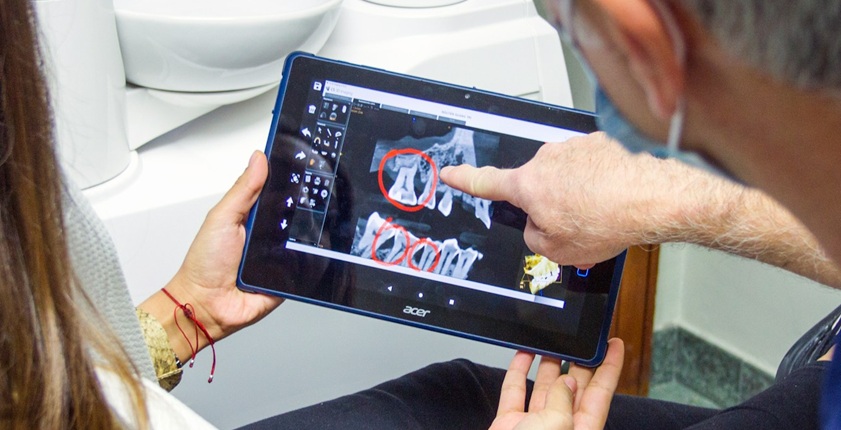
Treating Your Teeth Under a Microscope — When Should You Invest in a Microscope?
Modern dentistry is increasingly using advanced technologies that allow for more precise and effective treatment. One such solution is a dental microscope, allowing accurate viewing of tooth structures and surrounding tissues at high magnification. The dental microscope has become an invaluable tool in many specialized treatments, from endodontics to prosthetics. In this article, we will look at cases in which it is recommended to treat teeth with the use of this innovative technique. We will show the advantages of microscopy in dentistry and the treatment options available thanks to it, which can affect the comfort and effects of therapy.
Localization and treatment of complex root canal systems
The use of a dental microscope to locate and treat complex root canal systems is recommended for several key reasons. A dental microscope provides a clear, enlarged image of the internal structure of the tooth, which is necessary to identify all channels, including those that are difficult to access and poorly visible. Many root canals may be imperceptible during a standard examination due to their small size or complex geometry. Root canal treatment requires finding and working out not only visible channels, but also hidden ones. The microscope allows you to precisely navigate the complex arrangement of channels, minimizing the risk of missing any area, which is crucial to the success of treatment. Thanks to better visualization, the dentist can more accurately assess the degree of cleaning of the canals and shape them more effectively, which is important for subsequent filling with material. This, in turn, translates into a greater likelihood of permanent restoration of the tooth. The use of a microscope helps to precisely remove infected material from the canals, minimizing the risk of tissue residue left behind, which could lead to re-infection. In addition, this precision reduces the likelihood of damage to the tooth structure during the procedure. Thanks to thorough root canal treatment under a microscope, endodontically treated teeth can be preserved in a better condition, which translates into aesthetics and functionality of the tooth. In conclusion, the use of a dental microscope during root canal treatment allows to increase the accuracy and efficiency of procedures, which is extremely important for teeth with complex root canal systems. This is an investment in better treatment results, a lower risk of complications and a longer life of the treated teeth.
Root canal treatment of teeth at the dentist.
30 years of experience. Check us out.
Removing broken tools from root canals
The use of a dental microscope is recommended when removing broken tools from the root canals mainly due to the precision and safety of this procedure. Fracture of the endodontic tool in the root canal is a serious challenge and can complicate the course of treatment. The dental microscope has several key benefits in these situations. The microscope provides clear, magnified images of the internal structure of the canal, which makes it possible to accurately locate the broken fragment of the tool. Without proper magnification, it is difficult to even see such small elements in the depth of the tooth. Precise manipulation of the tools in the limited space of the root canal is crucial to safely extract the broken fragment without causing additional damage to the tooth. The microscope allows the doctor to accurately direct thin specialized tools that are used to remove broken parts. The use of a microscope allows you to avoid excessive removal of healthy tooth tissue, which could weaken its structure. With better visualization, the dentist can work with greater care and precision. After extracting the broken fragment, the microscope allows you to accurately assess whether the channel has been completely cleaned and whether there is any additional damage or tool residue. Effective removal of broken tools and appropriate follow-up root canal treatment are crucial to keeping the tooth in good condition. The use of a microscope increases the chances of preserving the tooth, even after such difficult complications.
Retreatment, or re-root canal treatment of teeth
Retreatment, or re-treatment of teeth that have previously been treated, is a procedure that requires exceptional precision, and the use of a dental microscope significantly increases the effectiveness and safety of this type of treatment. The microscope allows for detailed visualization of the inside of the canals, which is crucial for assessing the condition of existing fillings and for identifying potential problems such as micro-cracks, hidden channels that have not been noticed before, or remnants of inflamed tissue. Canal re-treatment often requires the removal of old materials, which can be difficult, especially if they have been firmly anchored. The microscope provides a precise view of the work and allows for more accurate removal of old materials without damaging the tooth too much. In cases where the previous treatment failed due to infection or other complications, the microscope allows an accurate assessment of the problem and targeted treatment. Precise purification of channels from pathogen residues is crucial to the success of the retreatment. The microscope makes it possible to minimize the removal of healthy tooth tissue during the re-development of the canals, which is important for maintaining the strength and stability of the tooth and increases the chances of preserving the tooth in the long term. After thorough cleaning of the canals, the microscope also helps to fill them accurately, which is crucial for preventing re-infection and ensuring the durability of the treatment.
Surgical removal of the apex of the tooth root
Surgical removal of the apex of the tooth root, also known as apicotomy, is an advanced dental procedure that involves excising the apex of the tooth root along with the surrounding infected tissue. The dental microscope provides better visibility of the operated area, which allows the surgeon to accurately locate the apex of the root and remove the infected tissue with high precision. This accuracy is crucial to remove the entire problem area while minimizing damage to healthy tissues. With better magnification and lighting, the surgeon can avoid disturbing anatomical structures such as nerves or adjacent tooth roots, which reduces the risk of complications such as pain or loss of sensation. Improved visibility and accuracy allow for more accurate removal of infected tissues and protection of the treatment site, which translates into a higher chance of treatment success and a lower risk of infection recurrence. In some cases, after removing the apex of the root, a retrograde filling of the root canal is performed. The microscope allows you to accurately prepare and fill the final part of the canal, which is important for the prevention of future infections. Precision surgical techniques using a microscope typically cause less tissue damage, which promotes faster healing and reduces patient discomfort after surgery. The dental microscope allows not only to carry out the procedure accurately, but also to record the procedure, which is helpful for educational purposes and when medical records are needed.
Thorough cleaning of gum pockets
Thorough cleaning of gum pockets, especially deep ones, is crucial in the treatment of periodontal disease. The microscope provides clear and enlarged images of the gingival pockets, allowing the identification and precise removal of tartar deposits and other contaminants that may be invisible to the naked eye. This is especially relevant in deep pockets, where it is difficult to reach with standard tools. With better view and control, treatment under a microscope allows gentle and less invasive manipulation of tissues, which reduces the risk of tissue damage and ensures faster healing of the gums. Removing bacterial plaque and tartar from deep pockets is crucial to stopping the progression of periodontitis. The microscope provides higher cleaning efficiency, which is necessary to achieve long-term stabilization of the periodontal condition. During the procedure, the microscope allows not only to remove impurities, but also to accurately assess the condition of the tissues and the effectiveness of the interventions performed. The dentist can assess how the tissues respond to treatment on an ongoing basis and adjust their actions. The less invasive approach that the microscope makes possible is often associated with less discomfort during and after the procedure, which improves the overall patient experience during treatment. Better visualization and control of the cleaning process translates into better clinical outcomes. Patients who have undergone a thorough cleaning under a microscope often experience fewer complications and faster progress in the treatment of periodontitis.
Detection of cracks or fractures
The dental microscope is an invaluable tool in dental diagnosis and treatment, especially in cases where it is necessary to detect small cracks or fractures of the tooth that are invisible to the naked eye. The dental microscope offers high magnification and excellent illumination of the working area, which allows you to clearly see even the smallest gaps and cracks on the surface of the tooth and in its structure. Such a detailed examination is unattainable by traditional inspection methods. Thanks to the ability to adjust the depth of field and contrast, the microscope helps the doctor distinguish between layers of tooth tissue, which is crucial in identifying cracks through enamel, dentin or cement. The microscope allows you to accurately trace the course of the rupture, which is important for both diagnosis and treatment planning. The dentist can assess how deep the crack is and whether it extends into the root canal, which is important for the prognosis and further management. Cracks can be confused with other dental problems, such as chipped edges, enamel anomalies or minor discoloration. The microscope allows you to precisely delineate these conditions, which is necessary for proper diagnosis and treatment. The microscope also allows you to take photos and videos of the treatment, which is helpful in medical records, long-term planning and communication with the patient. If it is necessary to treat a tooth with a crack, a dental microscope allows precise procedures such as removal of infected dentin, proper shaping of root canals or placement of fillings and other reconstructive materials.
Precise preparation of teeth for crowns and bridges
The dental microscope has become an invaluable tool in modern dentistry, especially in the field of precise preparation of teeth for crowns and bridges. Preparing a tooth for a crown or bridge requires the removal of a certain amount of tooth tissue to provide space for the crown to be placed. A dental microscope allows for fine grinding, minimizing the risk of removing too much healthy tooth tissue. Thanks to this, the tooth remains stronger and less vulnerable to damage. The edges of the preparation must be smooth and precisely shaped, which is crucial for the perfect fit of the crown. The microscope makes it possible to precisely finish these edges, which prevents the formation of gaps between the crown and the tooth, which could lead to caries or weakening of the tooth structure. Tooth preparation requires work in hard-to-reach places, such as interdental areas. The microscope provides a better visualization of these areas, which allows you to safely carry out the procedure. The withdrawal profile is the shape that the dentist gives to the tooth under the crown. It is crucial for the correct embedding of the crown and its durability. Thanks to the microscope, the dentist can accurately assess and correct the withdrawal profile, which increases the durability and aesthetics of the final filling. The precision of the work under the microscope allows to minimize the contact time of the tools with the tooth and control the force applied during processing, which reduces the risk of overheating and damage to the tooth. In order for the crown to function properly and look aesthetically pleasing, the margins of the crown must be perfectly aligned with the gum line. The microscope makes it possible to accurately assess and adjust these margins, which is important for periodontal health and the aesthetics of the smile. The precision of preparation under a microscope allows the creation of precise impressions and models for dental technicians, which in turn translates into a higher quality of the final prosthetic work.
Assessment of the quality of previous prosthetic and orthodontic work
The dental microscope, with its advanced magnification and excellent image quality, is an extremely useful tool in assessing the quality of performance of previous prosthetic and orthodontic work. A microscope allows you to see if crowns or bridges are properly aligned with the teeth and gum line. It can be examined in detail whether there are gaps between the tooth and the prosthetic work, which is crucial for the prevention of caries and periodontal disease. The microscope allows the detection of defects and irregularities on the surface of crowns, bridges or orthodontic appliances that could affect the patient's comfort or lead to problems with the bite. You can judge the quality of polishing and finishing of the material. Using a microscope, the dentist can show the patient detailed images that help in understanding the status of the work performed and the interventions needed, which increases the patient's involvement in the treatment process.
Treatment of teeth under a microscope is a relatively new practice that is gaining followers every year, because it brings benefits to both dentists and patients. Despite the higher cost of treatment, the benefits of using a dental microscope translate into greater treatment effectiveness, reduced risk of complications and patient satisfaction. Therefore, it is worth investing in a microscope.
Content author

Dr. Jan Kempa
Dr. Jan Kempa is a passionate dentist who always cares about a good relationship with patients. His positive attitude makes even the most timid patients feel safe. He specializes in implantology and dental surgery, using modern treatment techniques. He is enthusiastic about using his own tissues to rebuild bones before implantation and to cover gum recession. Dr. Kempa always finds the time to listen to the patient and offers individual solutions.

Start treatment already today!
Make an appointment and discover why our patients recommend us to their loved ones. We will take the utmost care of your smile.


